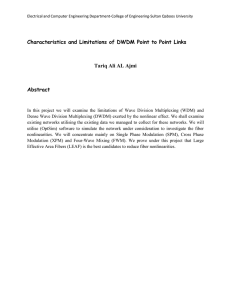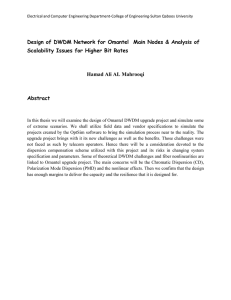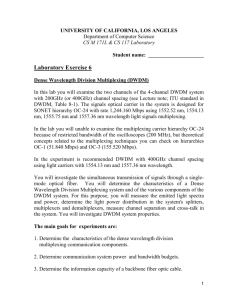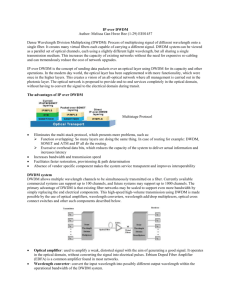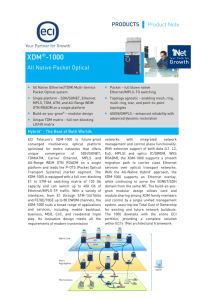Research Journal of Applied Sciences, Engineering and Technology 4(5): 530-532,... ISSN: 2040-7467 ©Maxwell Scientific Organization, 2012
advertisement
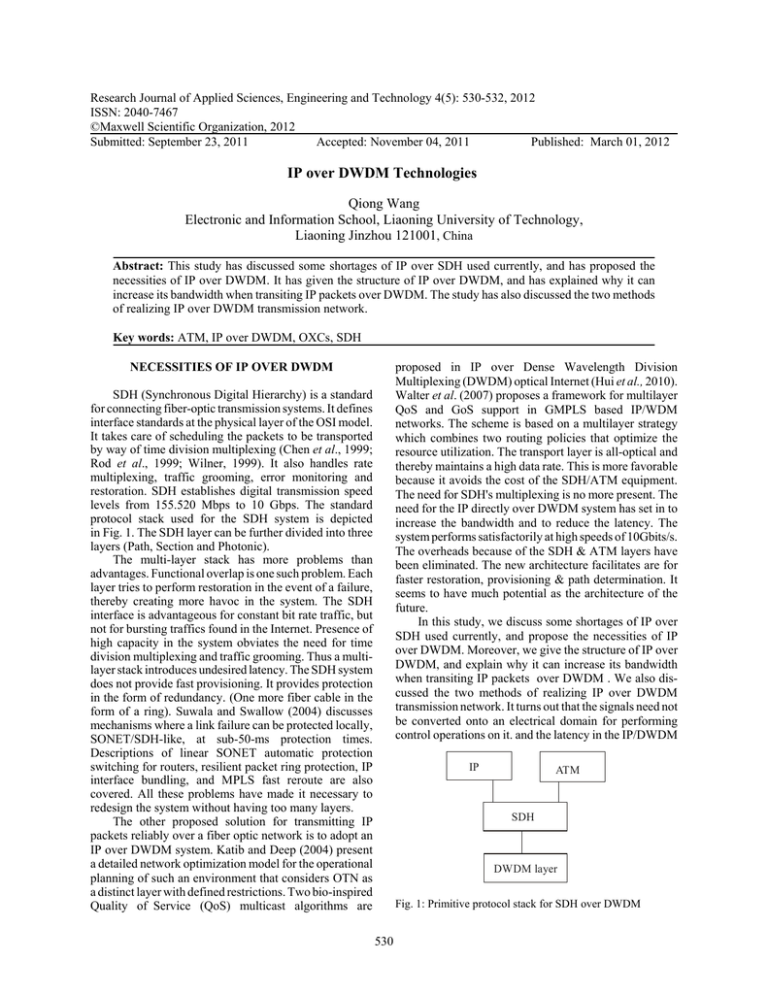
Research Journal of Applied Sciences, Engineering and Technology 4(5): 530-532, 2012 ISSN: 2040-7467 ©Maxwell Scientific Organization, 2012 Submitted: September 23, 2011 Accepted: November 04, 2011 Published: March 01, 2012 IP over DWDM Technologies Qiong Wang Electronic and Information School, Liaoning University of Technology, Liaoning Jinzhou 121001, China Abstract: This study has discussed some shortages of IP over SDH used currently, and has proposed the necessities of IP over DWDM. It has given the structure of IP over DWDM, and has explained why it can increase its bandwidth when transiting IP packets over DWDM. The study has also discussed the two methods of realizing IP over DWDM transmission network. Key words: ATM, IP over DWDM, OXCs, SDH proposed in IP over Dense Wavelength Division Multiplexing (DWDM) optical Internet (Hui et al., 2010). Walter et al. (2007) proposes a framework for multilayer QoS and GoS support in GMPLS based IP/WDM networks. The scheme is based on a multilayer strategy which combines two routing policies that optimize the resource utilization. The transport layer is all-optical and thereby maintains a high data rate. This is more favorable because it avoids the cost of the SDH/ATM equipment. The need for SDH's multiplexing is no more present. The need for the IP directly over DWDM system has set in to increase the bandwidth and to reduce the latency. The system performs satisfactorily at high speeds of 10Gbits/s. The overheads because of the SDH & ATM layers have been eliminated. The new architecture facilitates are for faster restoration, provisioning & path determination. It seems to have much potential as the architecture of the future. In this study, we discuss some shortages of IP over SDH used currently, and propose the necessities of IP over DWDM. Moreover, we give the structure of IP over DWDM, and explain why it can increase its bandwidth when transiting IP packets over DWDM . We also discussed the two methods of realizing IP over DWDM transmission network. It turns out that the signals need not be converted onto an electrical domain for performing control operations on it. and the latency in the IP/DWDM NECESSITIES OF IP OVER DWDM SDH (Synchronous Digital Hierarchy) is a standard for connecting fiber-optic transmission systems. It defines interface standards at the physical layer of the OSI model. It takes care of scheduling the packets to be transported by way of time division multiplexing (Chen et al., 1999; Rod et al., 1999; Wilner, 1999). It also handles rate multiplexing, traffic grooming, error monitoring and restoration. SDH establishes digital transmission speed levels from 155.520 Mbps to 10 Gbps. The standard protocol stack used for the SDH system is depicted in Fig. 1. The SDH layer can be further divided into three layers (Path, Section and Photonic). The multi-layer stack has more problems than advantages. Functional overlap is one such problem. Each layer tries to perform restoration in the event of a failure, thereby creating more havoc in the system. The SDH interface is advantageous for constant bit rate traffic, but not for bursting traffics found in the Internet. Presence of high capacity in the system obviates the need for time division multiplexing and traffic grooming. Thus a multilayer stack introduces undesired latency. The SDH system does not provide fast provisioning. It provides protection in the form of redundancy. (One more fiber cable in the form of a ring). Suwala and Swallow (2004) discusses mechanisms where a link failure can be protected locally, SONET/SDH-like, at sub-50-ms protection times. Descriptions of linear SONET automatic protection switching for routers, resilient packet ring protection, IP interface bundling, and MPLS fast reroute are also covered. All these problems have made it necessary to redesign the system without having too many layers. The other proposed solution for transmitting IP packets reliably over a fiber optic network is to adopt an IP over DWDM system. Katib and Deep (2004) present a detailed network optimization model for the operational planning of such an environment that considers OTN as a distinct layer with defined restrictions. Two bio-inspired Quality of Service (QoS) multicast algorithms are IP ATM SDH DWDM layer Fig. 1: Primitive protocol stack for SDH over DWDM 530 Res. J. App. Sci. Eng. Technol., 4(5): 530-532, 2012 Table 1: DWDM network model Transport layer Bandwidth, reliability Wavelength level Traffic-control Service layer Access speed, usage rates, Security, VoIP services etc ATM IP DWDM multiplexer system is less compared to that encountered in the SDH system. Virtual fibers Fig. 2: DWDM network structure OPTICAL INTERNET Cross conncet OXC M ux/dem ux Wavelength transponder Wave length transponder M ux/dem ux The fundamental properties of the DWDM system are exploited to form an all optical layer. Bit rate and protocol transparency enables transport of native enterprise data traffic like Gigabit Ethernet, ATM, SDH, IP etc. on different channels. It also brings in more flexibility so that the system can be connected directly to any signal format without extra equipment. The optical transport architecture will employ both transport networking and enhanced service layers, working together in a complementary and interoperable fashion. The functionality in the optical layer can be split as given in Table 1. The two layers perform the functions of the Three SDH layers. The transport layer acts like the lower physical layer, while the service layer acts like a higher layer. The two layers together achieve the granularity needed by all the services (like traffic engineering). In this model, the SDH gives way to the optical transport, which tries to achieve reliability and performance as provided by the standard SDH architecture. Having an intelligent optical layer that performs fast restoration can appease the bandwidth demand. Restoration happens in the optical layer rapidly and does not overlap with the service layer's mechanisms. Switching and bandwidth is furnished at the granularity of the wavelength. The ATM's virtual path becomes equivalent to a wavelength. Furthermore, the Multiprotocol Label Switching (MPLS) protocol divides the traffic engineering requirements between the IP layer and the Optical transport layer. Thus a DWDM layer with required functionality is molded to form the all-optical network. Achieving the benchmark set by SDH leads to many complex expectations. When a connection is established, the DWDM layer has to provide both reliable optical path and traffic engineering. An automated provisioning of end-to-end wavelength path should happen in a virtually less amount of time. In case of a physical failure, the wavelength routing protocol will have to restore the transcontinental paths across many routers within a maximum of 50 ms. These expectations bring about a vagueness in the extent to which some functionality should be pushed down to the optical layer. IP router Fig. 3: IP over OXCs network IP/DWDM systems adopted a new approach, which yields a whole new transport layer, called the Open architecture. It is open in the sense that it is not tied with SDH or other TDM systems. This case reflects protocol transparency and exhibits all the properties of the alloptical network. For optical networking to realize its full potential there must be a standard interface to the optical layer. The Fig. 2 denotes the open system. The customer is responsible for providing the actual interface to the end user and for all the protection work. The IP bits enter the DWDM system and then are transported over the highspeed connection. The IP/DWDM system can adopt a variety of architectures based on what the payload is and what the underlying transport network is. They can be grouped as: C C IP OVER DWDM STRUCTURE The DWDM layer has been designed in compliance with industry wide standards. This is the key for ensuring protocol and format transparency in the network. C 531 Optical mesh transport: OXCs and multiplexers are used to provide wavelength management and restoration. The Fig. 3 represents the IP over OXCs Network. In case of a physical failure, the signal is rerouted through a different physical path. Meshes provide the fastest way for restoration. Systems, which take care of the management functions, are also available at this time. Wavelength transport network: IP and ATM connect directly over the wavelength links. It is devoid of the OXCs. The detection of failure and restoration is done at the service layer. This has inherent advantages over the previous architecture in that one layer of equipment is avoided and restoration is at a different level. Lack of multiplexing layer between the service and the transport layer brings in added complexities. Thus, an open case with the wavelength transport network would be a practical implementation for an Res. J. App. Sci. Eng. Technol., 4(5): 530-532, 2012 ACKNOWLEDGMENT This study is supported by Natural Science Foundationof Liaoning Province and Innovation Research Foundation of Liaoning University of Technology. Many thanks for editor's kindly work for this study. REFERENCES Chen, Y., T.F. Mohammad, H.J. La Roche, Z.L. Jacob and L.N. Bruce, 1999. Detailed explanation of the optical layer issues, pertaining to metro-networks. Metro Optical Networking, Bell Labs Tech. J., 4(1): 163-186. Hui, C., X. Wang, S. Yang, M. Huang and J. Cao, 2010. QOS multicast tree construction in IP/DWDM optical internet by bio-inspired algorithms. J. Network Comp. Appl., 33(4): 512-522. Katib, I. and M. Deep, 2004. A network optimization model for multi-layer IP/MPLS over OTN/DWDM networks. IP Operations Manage., 5843(1): 180-185. Rod, C.A., A.B. Paul, J.N. Curtis, A.S. Kevin and L.V. Eve, 1999. A practical view point to the optical layer issues. Practical Vision Optical Transport Networking Bell Labs Tech. J., 4(1): 3-17. Suwala, G. and G. Swallow, 2004. SONET/SDH-like resilience for IP networks: A survey of traffic protection mechanisms. IEEE Network, 18(2): 20-25. Walter, C., S. Kris, N. Ann and L. Jan, 2007. Multilayer quality and grade of service support for high speed GMPLS IP/DWDM networks. Lecture Notes Comp. Sci., 4658(1): 187-196. Wilner, A., 1999. Technical explanation to the loss compensation and header replacement methodologies. Key limitations in WDM systems and networks, Conference Proceedings, SPIE, 71, pp: 220-245. Fig. 4: Wavelength transport network IP over DWDM system. The Fig. 4 indicates the wavelength transport network. However, the onset of higher expectations from the IP/DWDM system makes it essential to adopt the optical mesh transport instead, because OXCs helps ensure Quality of Service (QoS). CONCLUSION In this study, we discuss some shortages of IP over SDH used currently, and propose the necessities of IP over DWDM. Moreover, we give the structure of IP over DWDM, and explain why it can increase its bandwidth when transiting IP packets over DWDM. We also discussed the two methods of realizing IP over DWDM transmission network. The IP over DWDM system has inherent advantages because of the absence of many layers, thereby cutting down on the cost part. It turns out that the signals need not be converted onto an electrical domain for performing control operations on it. Hence, the latency in the IP/DWDM system is less compared to that encountered in the SDH system, and the system service is transparent. 532

